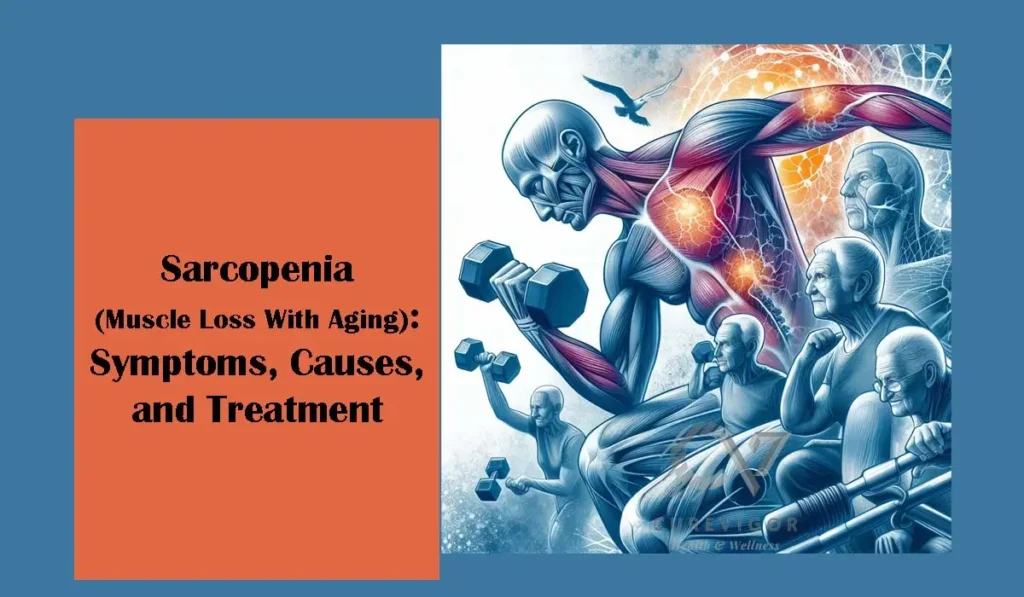Learn about sarcopenia, a condition characterized by muscle loss with aging. Discover its symptoms, causes, and treatment options to combat muscle weakness and maintain vitality.
Contents
- Sarcopenia: Symptoms, Causes, and Treatment
- Introduction to Sarcopenia
- Symptoms of Sarcopenia
- Causes of Sarcopenia
- Diagnosis of Sarcopenia
- Prevention of Sarcopenia
- Treatment Options for Sarcopenia
- Impact of Sarcopenia on Health
- Management Strategies for Sarcopenia
- Research and Future Directions
- FAQs
- Conclusion
Sarcopenia: Symptoms, Causes, and Treatment

Sarcopenia, a condition characterized by the progressive loss of muscle mass and strength, is a common concern among aging adults. As we age, our bodies undergo various changes, and one significant change is the gradual decline in muscle mass and function. This article explores the symptoms, causes, and treatment options for sarcopenia and the preventive measures individuals can take to maintain muscle health as they age.
Introduction to Sarcopenia
Sarcopenia, derived from the Greek words “sarx,” meaning flesh, and “penia,” meaning loss, is a condition that involves the gradual decline in skeletal muscle mass and strength. Sedentary lifestyles and poor nutrition can exacerbate this natural part of aging.
Muscles support our skeletal structure, facilitate movement, and maintain metabolic health. Therefore, the loss of muscle mass and function associated with sarcopenia can significantly impact an individual’s overall health and quality of life.
Symptoms of Sarcopenia
Muscle Weakness
One of the primary symptoms of sarcopenia is muscle weakness, which can manifest as difficulty in performing daily tasks such as lifting objects, climbing stairs, or even standing up from a seated position.
Decreased Muscle Mass
Another hallmark symptom of sarcopenia is the gradual loss of muscle mass, which may result in a noticeable decrease in muscle size and definition.
Impaired Physical Function
Sarcopenia can also lead to impaired physical function, affecting mobility and balance and increasing the risk of falls and fractures.
Causes of Sarcopenia
Ageing Process
The aging process contributes to the development of sarcopenia, as older adults tend to experience a decline in muscle mass and function due to changes in hormone levels, decreased physical activity, and impaired protein metabolism.
Lack of Physical Activity
A sedentary lifestyle, characterized by prolonged periods of sitting or inactivity, can accelerate muscle loss and weaken muscle strength, exacerbating the effects of sarcopenia.
Poor Nutrition
Inadequate protein intake, micronutrient deficiencies, and imbalanced diets lacking essential nutrients can compromise muscle health and contribute to the development of sarcopenia.
Hormonal Changes
Hormonal changes associated with aging, such as reductions in testosterone and growth hormone levels, can also contribute to the development of sarcopenia by affecting muscle protein synthesis and turnover.
Diagnosis of Sarcopenia
Diagnosing sarcopenia typically involves a combination of physical examination, muscle strength tests, and imaging studies such as dual-energy X-ray absorptiometry (DEXA) scans or magnetic resonance imaging (MRI).
Prevention of Sarcopenia
Regular Exercise
Regular physical activity, particularly resistance training exercises targeting major muscle groups, can help preserve muscle mass and strength and mitigate the effects of sarcopenia.
Balanced Diet
Consuming a balanced diet rich in high-quality protein, essential vitamins and minerals, and healthy fats is necessary for supporting muscle health and preventing sarcopenia.
Adequate Protein Intake
Ensuring an adequate protein intake, mainly from lean meats, poultry, fish, eggs, dairy products, legumes, and nuts, is crucial for maintaining muscle mass and function.
Hormonal Therapy
In some cases, hormone replacement therapy or other pharmacological interventions may be recommended to address hormonal imbalances associated with sarcopenia and promote muscle growth and repair.
Treatment Options for Sarcopenia
Resistance Training
Resistance training, also known as strength or weight training, involves exercises using resistance or weights to challenge and strengthen muscles. It effectively combats muscle loss and improves muscle function.
Nutritional Supplements
Supplementing with protein powders, amino acids, creatine, and other nutritional supplements may help support muscle growth, repair, and recovery in individuals with sarcopenia, especially those with inadequate dietary protein intake.
Medications
Certain medications, such as anabolic steroids or selective androgen receptor modulators (SARMs), may be prescribed in some cases to stimulate muscle growth and improve muscle strength in individuals with sarcopenia.
Physical Therapy
Physical therapy programs tailored to individual needs and capabilities can help improve mobility, balance, and functional independence in individuals with sarcopenia, enhancing overall quality of life.
Impact of Sarcopenia on Health
Untreated sarcopenia can have significant implications for health and well-being, including an increased risk of falls and fractures, loss of independence, decreased quality of life, and higher healthcare costs.
Management Strategies for Sarcopenia
Managing sarcopenia typically requires a multidisciplinary approach involving physicians, physiotherapists, dietitians, and exercise specialists collaborating to develop individualized treatment plans based on the patient’s needs and preferences.
Research and Future Directions
The ongoing study of the underlying mechanisms of sarcopenia and potential therapeutic interventions offers hope for improving diagnosis, treatment, and prevention strategies. It emphasizes the importance of early intervention and holistic management practices.
FAQs
Q. How do you fight sarcopenia muscle loss due to aging?
Incorporating regular exercise, particularly resistance or strength training exercises, is crucial to combat sarcopenia muscle loss due to aging. These exercises help stimulate muscle growth and improve muscle strength. Maintaining a balanced diet rich in protein, vitamins, and minerals is essential for supporting muscle health.
Consuming enough protein is especially crucial since it gives muscles the building blocks they need to grow and heal. Consulting with a healthcare professional or a certified personal trainer can also provide personalized guidance and recommendations for managing sarcopenia.
Q. How do I know if I have sarcopenia?
Several signs and symptoms may indicate the presence of sarcopenia. These include muscle weakness, decreased muscle mass, impaired physical function, and difficulty performing everyday tasks such as lifting objects or climbing stairs. If you experience any of these symptoms, especially as you age, it’s essential to consult with a healthcare professional for a comprehensive evaluation and diagnosis. Physical examinations, muscle strength tests, and imaging studies may be conducted to assess muscle health and determine the presence of sarcopenia.
Q. Can sarcopenia be reversed?
While sarcopenia is not entirely reversible, its progression can be slowed or mitigated through lifestyle interventions such as exercise, nutrition, and, in some cases, medication. Regular resistance training exercises can help build muscle mass and strength while ensuring an adequate intake of protein and essential nutrients that support muscle health. Early intervention and proactive management strategies can help individuals maintain muscle function and independence as they age.
Q. What causes sarcopenia?
Natural aging, sedentary lifestyles, poor nutrition, hormonal changes, and chronic health conditions can cause sarcopenia. People tend to lose muscle mass and function as they age because of changes in hormone levels, decreased physical activity, and impaired protein metabolism. Additionally, inadequate protein intake, micronutrient deficiencies, and imbalanced diets can compromise muscle health and contribute to its development.
Q. How does sarcopenia affect the body?
Sarcopenia primarily affects skeletal muscles, which support the body’s structure, facilitate movement, and maintain metabolic health. Skeletal muscles are attached to bones and work together to allow us to perform various activities and functions, from walking and running to lifting and carrying objects. As the disease progresses, individuals may experience muscle weakness, decreased muscle mass, and impaired physical function, which can impact overall health and quality of life.
Q. What does muscle wasting feel like?
Muscle wasting, or muscle atrophy, often manifests as a gradual loss of muscle mass and strength over time. Individuals with muscle wasting may experience symptoms such as weakness, fatigue, decreased endurance, and difficulty performing everyday tasks. Muscle wasting can affect mobility, balance, and coordination, making engaging in physical activities or maintaining independence challenging. It can also increase susceptibility to injuries, falls, and fractures. If you suspect muscle wasting, it’s essential to consult with a healthcare professional for a thorough evaluation and appropriate management.
Conclusion
In conclusion, sarcopenia is a common age-related condition characterized by the progressive loss of muscle mass and strength, which can significantly impact an individual’s health and quality of life. By understanding the symptoms, causes, and treatment options for sarcopenia, individuals can take proactive steps to preserve muscle health as they age and maintain independence and vitality.
Read more articles on Health and Wellness.
You might like to read:



